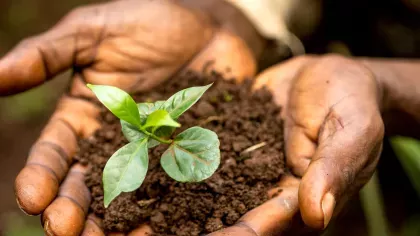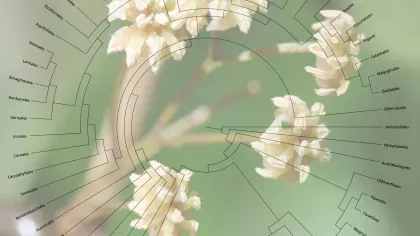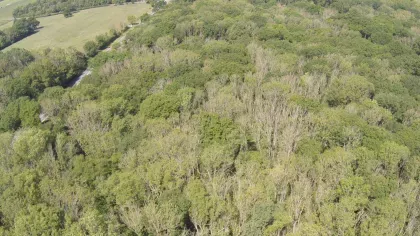6 November 2018
Plant cryobiotechnology at Kew: past, present and future
If we want to preserve the Earth’s ecosystems for future generations we need to use all of the conservation tools available. This includes an urgent investment into cryobiotechnology.

What is cryobiotechnology?
Seed banks are one of the most powerful tools of ex situ conservation of plants. There are more than 1,300 seed banks in the world, including Kew’s very own Millennium Seed Bank (MSB). Seed banks can potentially conserve seeds for centuries when seeds are dried, and then stored at temperatures of a home-freezer (about -20°C). They are essential not only for the conservation of biodiversity, but also for food security.
Conventional seed banking requires seeds to be dried before they are frozen. However, some species, including trees such as oaks, chestnuts and silver maple, produce seeds that are sensitive to the drying process and do not survive. These are described as “recalcitrant” seeds. For these species alternative methods must be developed. These approaches are increasingly known as cryobiotechnology and involve the use of plant biotechnology (e.g. micropropagation) and cryopreservation (i.e. the use of liquid nitrogen to cool down samples quickly and store them at ultra-low temperatures ̶ often -196 °C- ten times colder than a home freezer!).
Kew has been a pioneer in this area and is leading on the basic and applied research, to ensure we have the knowledge, tools, and facilities for the preservation of all plants and fungi.
Which species need cryobiotechnology?
It’s predicted that almost 50 per cent of tropical trees and shrubs produce recalcitrant seeds that do not cope with desiccation and -20°C storage. These include those forming the canopy of tropical forests such as the Amazon, as well as commodity species such as avocado, mango, lychee and cocoa.
There is an undetermined number of seeded plants that, even producing seeds that tolerate drying, store poorly at -20°C. For example, seeds of poplars and willows have lifespans of only around 15 years in a conventional seed bank and seeds with a high oil content such as coffee and papaya seeds, die faster when stored dry at -20°C compared with when stored at 5°C.
There are also a minority of species that do not produce seeds (for example when pollinators are missing), seeds that are inaccessible to collection, such as rare large trees growing in remote areas of the Amazon, specific genotypes that we need to preserve (e.g. crop and forestry clonal varieties used for high production) or non-seed-bearing plants (bryophytes and pteridophytes). Finally, there are also fungi.
However, estimating the number of wild plant species that need cryobiotechnology for long-term ex situconservation is a difficult and controversial task, due mostly to the lack of empirical data and the tremendous diversity of responses of wild plant species. A variety of studies from Kew scientists have estimated that these numbers could range between a quarter to two-thirds of the world’s plant species. But the real numbers are still uncertain and require deeper and careful research. For example, for certain groups of plants (e.g. threatened trees, Cycas, orchids and ferns) from certain habitats (e.g. China´s forests), ex situ conservation through seed, embryo or spore storage is likely to be enhanced by cryobiotechnology, benefitting up to two-thirds of such species. But if we consider other estimations of the overall number of seeded plants from all around the world, only up to a quarter of these species would need cryobiotechnology, conventional seed banking being the most cost-effective means of ex situ conservation.
How is Kew developing cryobiotechnology?
Kew has been working in cryobiotechnology for over 30 years. Over the last three years we have been studying variation in the responses of seeds to drying and liquid nitrogen exposure with a focus on European temperate forest tree species such as oaks and horse chestnuts.
One of our aims is to understand the mechanisms of survival and the death of seed embryos upon desiccation and exposure to (and storage at) low temperatures. To find out, we’re using a range of technologies from micropropagation to X-ray microcomputer tomography (micro CT), a technique which scans the seed to create high resolution 3D images.
Working in collaboration with the National History Museum, and Kew researchers Chrissie Prychid and Maria Conejero, we have optimised the micro CT approach for oak species. This will help us determine why some oak species can tolerate partial desiccation and liquid nitrogen exposure, such as the Pyrenees oak, while other species, such as the English oak, cannot. With around 600 species of oak found globally, our research will help design improved cryopreservation methods.
The future of cryobiotechnology at Kew
Plant cryobiotechnologies are being developed and implemented by researchers all around the world, but mainly in the agriculture, forestry and horticulture fields. Cryopreservation is an important method for the long-term conservation of crops to ensure we have a “back up” of all of these species and varieties. Kew has also highlighted the need for plant cryopreservation for the safeguardig of wild species for which conventional seed banking methods do not provide a feasible option. In the future, Kew hopes to develop a new cryobiotechology facility which will be dedicated to the study of low temperature biology and plant cryobiotechnology, allowing for the cryopreservation of multiple species.
Thanks to
The Garfield Weston Foundation and Kew Pilot Study for funding.
References
- Wyse, S.V., Dickie, J.B. & Willis, K.J. (2018). Seed banking not an option for many threatened plants. Nature Plants, 4: 848–850
- Che, H., Yu, X., Zhang, X., Yang, L., Huang, X., Zhang, J., Pritchard, H.W. & Li, W. (2018). Phospholipase Dα1-mediated phosphatidic acid change is a key determinant of desiccation-induced viability loss in seeds. Plant Cell Environ. 41(1):50-63.
- Ballesteros, D., Pence, V.C. (2017). Survival and death of seeds during liquid nitrogen storage: a case study on seeds with short lifespans. Cryo-Letters 38(4): 278-289.
- Pritchard, H.W., Nadarajan, J., Ballesteros, D., Thammasiri, K., Prasongsom, S., Malik, S.K., Chaudhury, R., Kim, H-H., Lin, L., Li, W-Q., Yang, X-Y. & Popova, E. (2017). Cryobiotechnology of tropical seeds – scale, scope and hope. Acta Horticulturae 1167: 37 - 48.
- Merrett-Wade, E., Nadarajan, J., Yang, X., Ballesteros, D., Sun, W., Pritchard, H.W. (2016) Plant species with extremely small populations (PSESP) in China: a seed and spore biology perspective. Plant Diversity, 38(5): 209–220.
- Nadarajan, J., Pritchard, H.W. (2014) Biophysical Characteristics of Successful Oilseed Embryo Cryoprotection and Cryopreservation Using Vacuum Infiltration Vitrification: An Innovation in Plant Cell Preservation. PLoS ONE 9(5): e96169. https://doi.org/10.1371/journal.pone.0096169
- Roach, T., Ivanova, M., Beckett, R. P., Minibayeva, F. V., Green, I., Pritchard, H. W., Kranner, I. (2008). An oxidative burst of superoxide in embryonic axes of recalcitrant sweet chestnut seeds as induced by excision and desiccation. Physiologia plantarum 133(2): 131-139.
- Pritchard, H.W., Prendergast, F.G. (1986) Effects of Desiccation and Cryopreservation on the In Vitro Viability of Embryos of the Recalcitrant Seed Species Araucaria hunsteinii K. Schum. Journal of Experimental Botany 37(182): 1388-1397.



